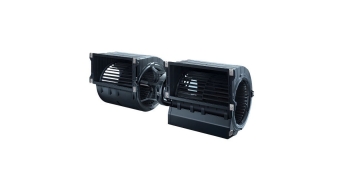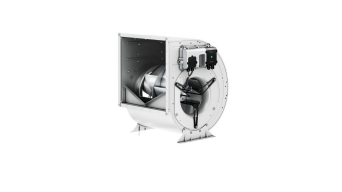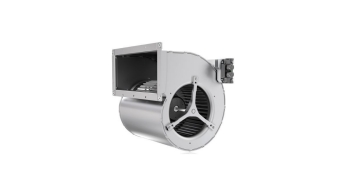FCU types and EC fan options
The aforementioned benefits of EC fans as FCU fans are just the beginning. As ebm‑papst continues to innovate, our EC fans will be engineered with more smart and advanced features, enabling even further energy optimisation.
We will tailor our recommendation to your technical needs. For a quick overview of the fan types we have on offer as FCU fans, take a look below.
Small fan coil units: Small FCUs are often located found in hotel rooms. We recommend our EC fan blowers. For this fan model, we offer it in single, twin and triple blower versions.
Large fan coil units: Large FCUs are often located found in shopping malls, exhibition halls, ballrooms and meeting rooms. We recommend our RadiFit or EC centrifugal fans with high static pressure for these FCUs.
Reasons to upgrade your FCU Fans
The direct benefits of energy-saving fans are clear – less energy consumed equates to lower operational costs. However, there are several other less prominent benefits that merit discussion.
Scientific consensus globally indicates that in order to avoid the most dangerous consequences of climate change, humanity must cut carbon dioxide (CO₂) emissions by around 45% from 2010 levels by the year 2030, with a target of achieving net-zero emissions by 2050. The ongoing rise in global temperatures is closely linked to the cumulative amount of CO₂ emitted. Therefore, any continued emissions will further drive climate warming and intensify associated risks.
In response, incorporating energy-efficient solutions—like ebm‑papst’s EC fan technology in building systems—can play a vital role in curbing emissions and supporting the worldwide push toward a more sustainable future.Source: Netzeroclimate.org
Improving a building's energy efficiency starts with understanding how energy is consumed across its various systems. According to a 2018 report by the Building and Construction Authority (BCA), the primary energy-consuming components in buildings include mechanical systems like HVAC (heating, ventilation, and air conditioning), lighting, and vertical transportation. Cooling alone can account for up to 60% of a building's total energy use, with ventilation making up around 10%.
HVAC systems rely on a range of equipment—including pumps and fans—to function, and fans alone can contribute to as much as 35% of HVAC energy consumption.
Given this, enhancing the energy performance of HVAC systems is a critical step toward cutting overall energy usage in buildings.
Key HVAC components such as air handling units (AHUs), cooling towers, condensers, and fan coil units work in tandem to deliver cooling and ventilation. A consistent feature among these systems is the use of fans to distribute air. In many older buildings across Singapore, these fans are often driven by traditional AC motors, which were once the norm. One highly efficient upgrade involves replacing these outdated AC fans with advanced Electronically Commutated (EC) fan technology—offering substantial energy savings and improved system performance.
Sources: BCA and NCCS
The region is increasingly adopting environmentally conscious building regulations. Incorporating EC fan technology into your projects can significantly improve your chances of complying with these evolving government standards. Below are some examples of green building initiatives across Southeast Asia:
Singapore: Singapore Green Building Masterplan, MEI Regime, Energy Conservation Act
Malaysia: Green Technology Masterplan 2017 - 2030
Thailand: Thailand Energy Efficiency Development Plan 2015-2036
Indonesia: Indonesia launches National Roadmap for Green Building Implementation
Vietnam: National Energy Efficiency Programme 2019 - 2030
Philippines: Republic Act 11285
Our integrated EC fan system is designed for greater energy efficiency compared to traditional setups, minimizing energy loss during operation. This also leads to reduced heat generation, which can help prevent premature wear and extend the lifespan of the equipment.
As a result, operational expenses are lowered, and from a sustainability standpoint, longer-lasting products are more environmentally friendly since they reduce the frequency of replacements and associated waste.
Sustainability has emerged as a critical consideration for companies searching for office space, ranking alongside traditional factors such as location and access to talent. Even in a sluggish leasing environment, demand for energy-efficient, low-carbon buildings is on the rise, with many businesses willing to pay more for environmentally friendly workspaces. According to JLL, this "green premium" translates to rental increases of 7.1% in North America, 9.9% in Asia Pacific, and 11.6% in London. Kirsty Draper of JLL notes that since office buildings contribute directly to a company's carbon footprint, sustainability is becoming a core element in corporate real estate decisions as firms work to meet environmental goals and demonstrate climate leadership.
Source: JLL
Why choose ebm‑papst?
We aim to achieve climate-neutral production in the 2025/26 financial year. This means reaching climate neutrality in Scope 1 and 2. Sustainability has been at our core since our founding: each product we create must surpass its predecessor in economic and ecological performance, contributing to the sustainability of our customers' applications as well.
Since our pioneering integrated electronics before the millennium to today’s networked solutions, we deliver digital value to your applications. Through demand-driven operations, remote monitoring, predictive maintenance, and AI-driven buildings, we collaborate to find solutions that lower costs, save energy, and reduce emissions.
Founded on the belief in pioneering engines and groundbreaking EC technology, innovation has always driven our success. With substantial global investments in R&D, we continuously advance technology, enhancing our customers' applications and embodying technology leadership.
Our global presence ensures we offer rapid, customer-centric solutions while understanding local nuances and languages. By adapting our supply chains locally, we enhance responsiveness and reduce our CO2 footprint. This "local for local" approach allows us to meet customer needs swiftly and efficiently, contributing to a more sustainable future.
Download our FCU fan info packet
This information packet serves as a collection of FCU fan content, specially curated for built environment professionals such as building owners, facility management and installation/maintenance staff. The packet includes...
1. [Brochure] Discover ebm‑papst for hotels: This brochure offers an overview of the EC fans we have that are ideal for fan coil units in hotels.
2. [Flyer] FCU fan projects with estimated cost savings & CO2 reductions in Singapore: This flyer details an overview of our successful FCU fan retrofit in a hotel in Southeast Asia. It includes the estimated annual cost savings due to reduced energy consumption and the estimated amount of carbon dioxide emissions that was reduced as a result of the FCU fan retrofit.


